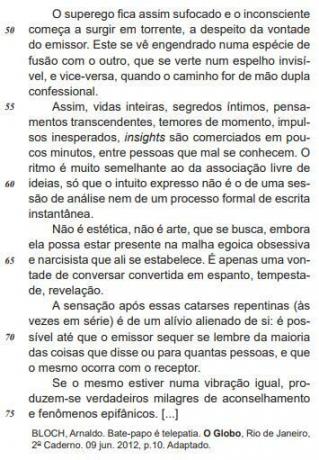Gradation or climaxit's a figure of speech which involves the intensification of an idea through the use of words related to that concept. Since climax is the most common form of gradation, it is its best known type and also another way of referring to it. Besides climaxes, there are two other types of gradation: anticlimax and concatenation.
Read too: Antithesis — the figure of speech that uses opposing terms to intensify the meaning of an idea in speech
Topics of this article
- 1 - Summary on gradation
- 2 - What is gradation?
- 3 - What is the effect created by the gradation?
-
4 - What are the types of gradation or climax?
- → Climax (or ascending/ascending gradation)
- → Anticlimax (or descending/descending gradation)
- → Concatenation (or epiplox)
- 5 - Solved exercises on gradation or climax
gradation summary
Gradation is a figure of speech. More specifically, é a figure of thought.
The other way it is called, climax, is one of the types of gradation.
The types of gradation are: climax, anticlimax and concatenation.
The climax occurs when words are used that gradually intensify an idea in the utterance.
The anticlimax occurs when the sequence of words goes from the most intense idea to the mildest or least intense.
Concatenation occurs when the sequence in the utterance is made by repeating the previous word.
What is gradation?
Gradation is a figure of speech, being classified more specifically as a figure of speech. thought for creating a sense effect in the text through a concept, an idea expressed by certain words.
Do not stop now... There's more after the publicity ;)
What is the effect created by the gradation?
the gradation intensifies the meaning of an idea through the use of words related to this concept, so that this idea becomes more and more intense in the statement. Note the following example:
I always thought you were a person smart, beautiful, beautiful, gorgeous...
Notice how the idea of beauty expressed in the statement becomes more intense with the enumeration that occurs when they position themselves the words “handsome”, “beautiful”, “beautiful”, “stunning”, one after the other, conveying an increasingly strong message.
now see this tweet from the singer Rita Lee, which went viral on the networks a long time ago:

There are two types of gradation in it. The first is descending, when you move from a more intense idea to a less intense one; in this case, the reduction in welfare:
I'm a jewel!!! - I'm great.. - I am fine... - Okay, I'm more or less...
The second is ascending, when moving from the least intense idea to the most intense; in this case, the intensification of the malaise:
ok, I'm more or less... - Yeah, I'm cool... - I'm bad... - I'M SOOOOOOOOOOOOOOOOOOOOOOOOOOOOOOOOOOOOOOOOOOOOOOOOOOOOOOOOOOOOO
What are the types of gradation or climax?
There are a few types of gradation: the climax, the anticlimax and the concatenation.
→ Climax (or ascending/ascending gradation)
The climax, also called up/down gradation, arrange the words from mildest to most intense, making the meaning of the statement stronger. See the example below:
The first million owned excites, sharpens, cunning millionaire's gluttony. (Olavo Bilac — 1865-1918)
In this case, we see the intensification of the idea of how the first million can instigate the millionaire's gluttony: the sequence between the verbs “excites”, “acirra” and “assanha”, making this feeling much more accentuated.
See another example below:
Oh, do not let mature age / turn you into this flower, this beauty / into Earth, in ashes, in dust, in shadow, in anything. (Gregorio de Matos — 1636-1696)
In this excerpt, we see how gradation intensifies the idea of decomposition and dematerialization of being, moving from “earth” to “ashes” and “dust”, followed by “shadow” and, finally, “nothing”.
→ Anticlimax (or descending/descending gradation)
The anticlimax, also called descending/descending gradation, arrange the words from more intense to milder, attenuating the meaning of the utterance, making it softer. See the example below:
He bragged about, but he could hardly establish order in his neighborhood, your House, your room.
In this example, a descending gradation can be seen through the words “neighborhood”, “house”, “room”.
See another example below:
If I had known, I would not have spoken, but I spoke for the veneration, for the esteem, for the affection, for fulfill a bitter duty […]. (Machado de Assis — 1839-1908)
Here, there is an anticlimax in the motivations for saying something, falling from “veneration” to “esteem”, passing through “affection” and ending with “fulfilling a bitter duty”, which is a less strong motivation than the others.
→ Concatenation (or epiplox)
Concatenation, also called epiplox, is a specific type of gradation in which a kind of interlacing occurs. In it, right after an utterance comes another to intensify the meaning of the previous one, but repeating an element of the previous one to reinforce the link between these utterances. See the example below:
From the intemperance of eating, however much gluttony tempers it, are born the crudities; of the rawness, the confusion and discord of moods; of discordant moods and decomposed, the diseases; It is of diseases, the death. (Priest Antonio Vieira — 1608-1697)
In this sermon by Father Antônio Vieira, it is noted how the gradation is made by intensifying the severity and impurity of the concepts: intemperance in eating – rawness – discord of humors – illnesses – death. However, in each new utterance, the previous element is resumed, repeating it. Then there is the effect of concatenation.
See too: Euphemism — the figure of speech used to make a statement more bland or pleasant
Solved exercises on gradation or climax
question 1
(Vunesp — adapted) Read the chronicle “Beijos”, by Ivan Angelo, to answer the question.

Gradation is a language resource characterized by the exposition of ideas through a sequence of words or expressions, whose progression can give greater or lesser intensity to the situation narrated.
In the chronicle, an example of gradation is found in the passage:
A) A feeling immersed in ambiguity: that could be a beneficial thing and at the same time could be a sin.
B) Only the best friend knew; brothers, no way; father, mother - never.
C) As a result of this climate, a shortcut emerged, a true guerrilla attack: the stolen kiss.
D) But there is a fine difference between naturalness and exhibitionism.
E) I found a survey showing that kissing is the caress preferred by Brazilians.
Resolution:
Alternative B.
The idea of progression is in the sequence that begins with “I got to know”, continues with “Never think” and ends with “Never”.
question 2
(Cesgranrio)


Among the excerpts transcribed below, which one presents, in the text, a decreasing gradation?
A) “in visits and meetings with body and voice present” (L.3)
B) “days, weeks, months” (L.11-12)
C) “a word, a syllable, an interjection sign” (L.17-18)
D) “on a large scale, bringing a whole new range of informational spheres” (L.22-23)
E) “a conversation starts, interrupts, ends or continues” (L.27-29)
Resolution:
Alternative C.
In “word”, “syllable” and “interjection sign”, it is noted that the idea changes from more communicative to less communicative. Alternative B brings increasing gradation by increasing the waiting time (“days, weeks, months”).
By Guilherme Viana
Portuguese teacher
Understand what antithesis is and how this figure of speech affects speech. See examples of its use, and learn the difference between antithesis and paradox.
Click here, understand what the apostrophe is and find out what differentiates it from the apostrophe.
Language and Communication: Learn about the interesting relationship between euphemism and speech.
Know what figures of speech are. Know the pictures of words, thought, syntax and sound. Also, do exercises to fix the content.
Find out what are the figures of thought, what are their characteristics and meaning effects, in addition to checking examples and fixation exercises.
Learn what hyperbole is and see examples of this figure of speech, in addition to solving some exercises to fix the content.
Know what irony is and know what types exist. See some examples of this figure of speech and solve the proposed exercises.


